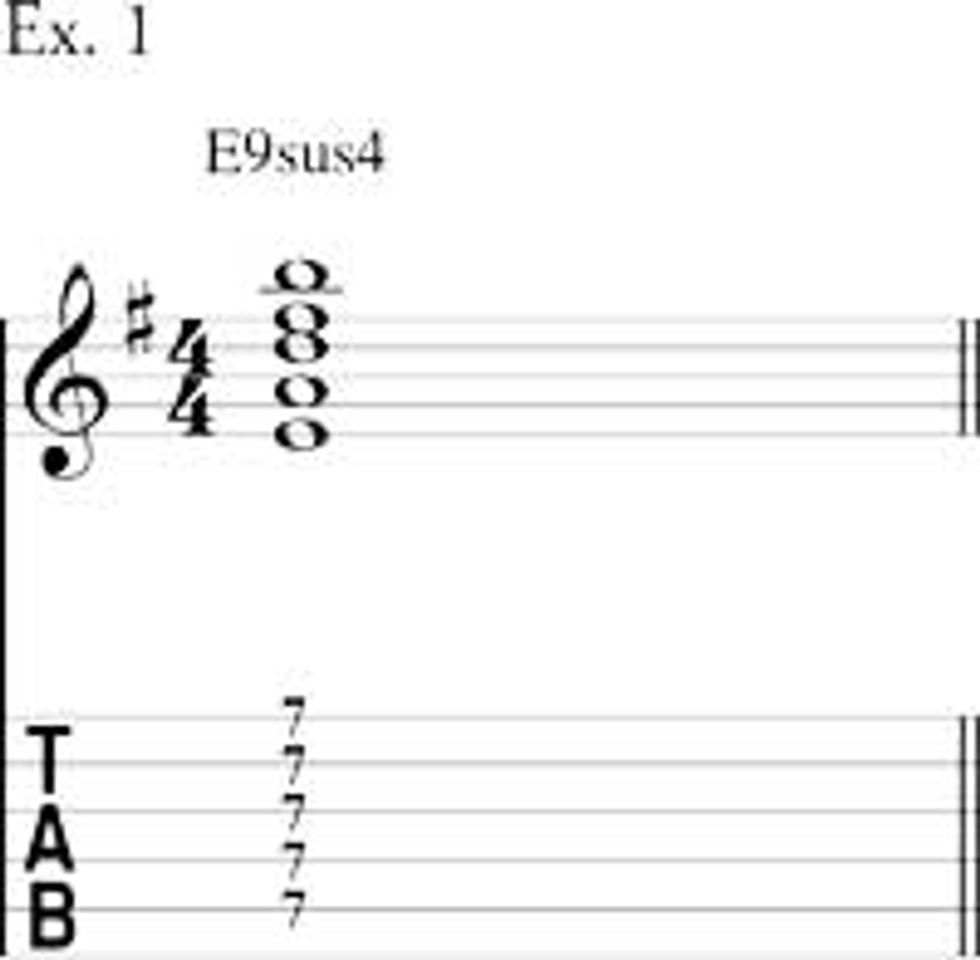Chops: Intermediate
Theory: Intermediate
Lesson Overview:
• Learn how to incorporate sus and add9 chords into your riffs.
• Draw inspiration from African guitar styles.
• Create interlocking guitar parts based on different rhythmic cycles.
Click here to download a printable PDF of this lesson's notation.
The 1980s was an eclectic and vital period for guitar music. Between the renaissance of neo-classical shred ushered in by Yngwie Malmsteen, the rise of hardcore punk, thanks to Bad Brains and Minor Threat, and the blues revival sparked by Stevie Ray Vaughan, the ’80s was especially diverse. These styles were also trendsetters—or revivalist in Vaughan’s case—as their influences are still heard today.
Ironically, the most iconic ’80s guitar sounds that were birthed out of the so-called “new wave” movement seem to have done little to influence current pop and rock music. So what do you say we change all that by revisiting the clean, compressed, punchy, chorus-laden sounds of bands like the Police, the Pretenders, the Smiths, Talking Heads, and many more.
In this lesson, we’ll look at some of the defining characteristics of this style, highlighting the work of such players as Andy Summers, Johnny Marr, Robert Fripp, and a few lesser-known guitarists whose playing encapsulated the sound of the decade. So grab that chorus pedal, some ambient delay, and let’s get started.
The One-Finger Barre Chord
This unusually simplistic concept can produce a wealth of harmonic possibilities and can be heard in such songs as “When the World is Running Down” by the Police, “Everybody Have Fun Tonight” by Wang Chung, “One Thing Leads to Another” by the Fixx, and others. It requires only this: Lay your index finger flat across five strings … and play with a smart bassist.
Ex. 1 labels the chord in its most basic, non-bass-related form, which is E9sus4. But once your bass player starts adding some notes, the chord effortlessly changes functions.
Ex. 2 features that same chord, but this time with a bass line that emphasizes a B minor pattern. It can also be thought of as Bm11.
Click here for Ex. 2
On the other hand, if a D is emphasized in the bass line you get a D6/9 sound as shown in Ex. 3. Throw in a few more bass notes—in this case, G and E—and suddenly our static, one-finger barre chord progression turns in D6/9–G6/9–D6/9–E9sus4.
Click here for Ex. 3
“Add” and “Sus” chords
All these chords call to mind countless other ’80s classics, most notably several by the Police—thanks in large part to the inventiveness of Andy Summers. There isn’t space here to discuss the theory behind “add” and “sus” chords (we’ll save that for a future lesson), but these voicings can serve you well, even if you don’t know the theory behind them.
Ex. 4 provides the most iconic of sus9 chord shapes, which you can find in “Message in a Bottle,” “Secret Journey,” and “De Do Do Do, De Da Da Da.” By adding the fourth finger to a power chord shape, and playing it as an arpeggio, a run-of-the-mill chord progression suddenly has new life. I should point out these are all sus chords, and thus are neither major nor minor. Stripped of the sus harmonic colors, the implied chord progression would be C–Am–Dm–F.
Click here for Ex. 4
Ex. 5 is an example of strummed “add” chords found in the songs of the Smiths, R.E.M., the Pretenders, and even Rush’s forays into new wave. By simply removing the barre from these chord shapes, normal E, B, G, and A chords transform into E5, Badd11, G6, and Aadd9, respectively. These voicings sound particularly lush on a 12-string.
Click here for Ex. 5
Interlocking Guitar Parts
The final, and most complex concept we’ll look at has its roots in both African music and Balinese gamelan percussion. Paul Simon’s landmark recording Graceland, which was performed primarily with African musicians, is the most obvious point of reference for this type of playing, but it was Talking Heads and the 1980s incarnation of King Crimson that twisted and incorporated these musical ideas into new wave.
Ex. 6 features a dual-guitar, Graceland-inspired approach that, while decidedly not new wave, nevertheless demonstrates the concept of interlocking guitar parts and offers an example of the African roots of such playing.
Click here for Ex. 6
Ex. 7 meanwhile is more akin to the early music of Talking Heads, which, though primarily composed by lead singer/guitarist David Byrne, frequently featured guitarists Robert Fripp and Adrian Belew as sidemen handling the more intricate parts. Songs like “I Zimbra” and “Born Under Punches (the Heat Goes on)” are good examples of such interplay. Be sure to stay loose with your right hand.
Click here for Ex. 7
Our final example (Ex. 8) takes these interlocking parts to a new level, once again featuring ideas drawn from Fripp and Belew, but this time inspired by such King Crimson songs as “Frame by Frame” and “Discipline.” This example features two looping guitar parts built from eighth-note patterns that are organized into different rhythmic groupings. The repeating pattern in Gtr. 1 contains eight notes; Gtr. 2’s repeating pattern consists of seven notes. Though these two parts start simultaneously, they only come back together after Gtr. 1 cycles around seven times and Gtr. 2 cycles eight times!
Click here for Ex. 8
The ’80s in the Future?
As I mentioned in the introduction, very little of the sound of ’80s new-wave guitar has found its way into the hands of the 21st-century guitarist. This is a pity because, as much as the chorus and ambient delay guitar sound is a cliché, the playing itself is clever, unique, and, quite frankly, timeless. I recommend searching for a ’80s mix on YouTube or Spotify and listening to as many songs as you can, even if it’s not your preferred style. There is a wealth of refinement and subtlety hidden in the classic ’80s bands discussed here.



















